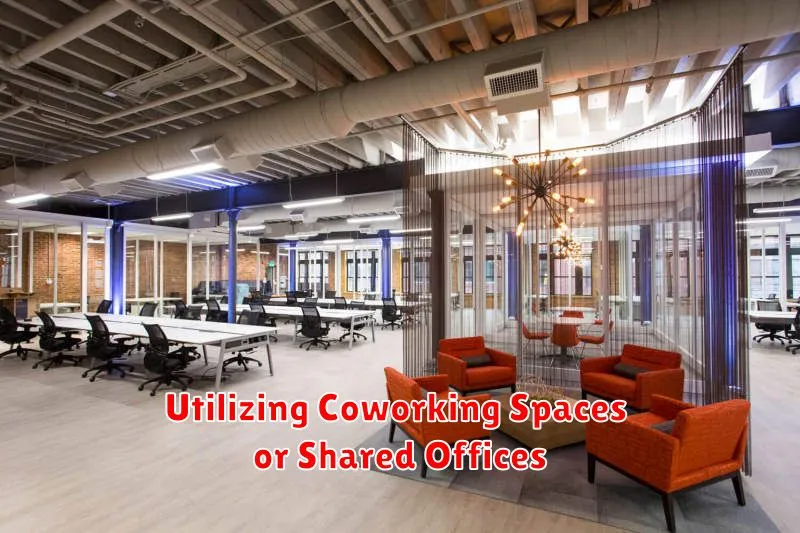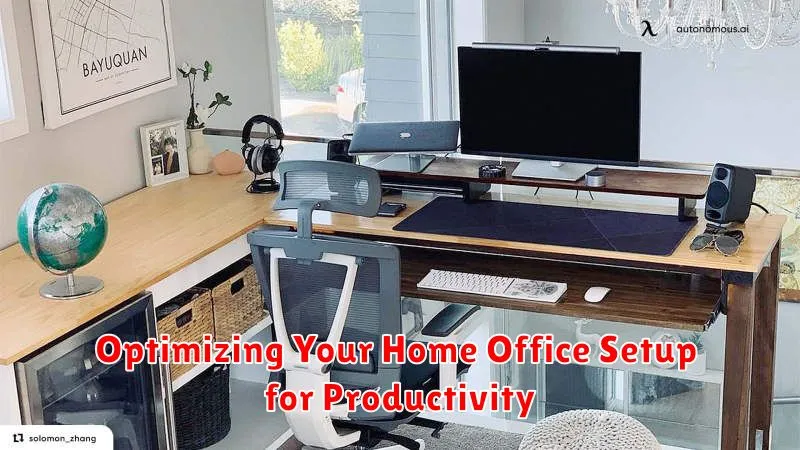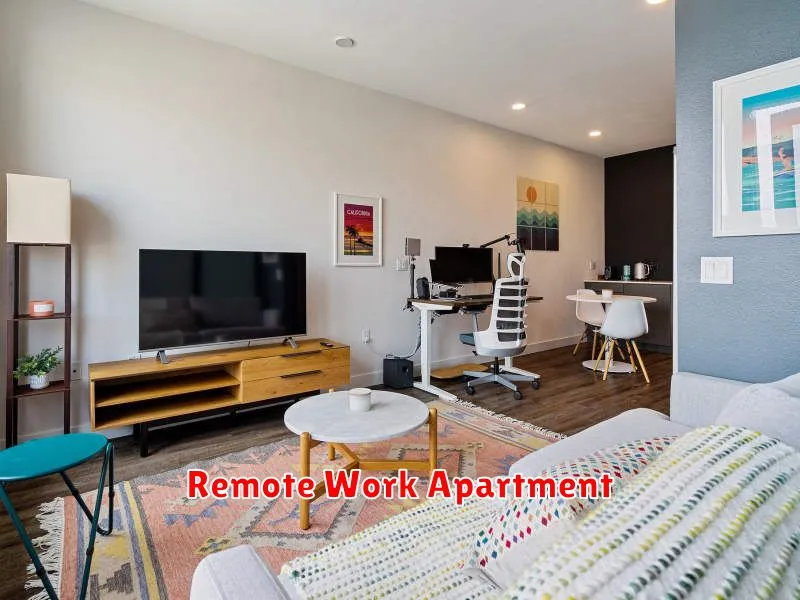Are you a remote worker looking for the perfect apartment to call your new home office? Finding the right place can be a challenge, especially when you need to consider factors beyond just your commute. This guide offers essential apartment renting tips for remote workers, covering everything from internet speed to workspace setup. Whether you’re a seasoned digital nomad or just starting out, this article will help you find an apartment that fosters productivity, comfort, and a healthy work-life balance.
Setting Up a Dedicated Workspace in Your Apartment
Working from home can be incredibly convenient, but it’s also easy to get distracted. That’s why creating a dedicated workspace in your apartment is crucial for remote workers. Having a designated area for work can help you stay focused, organized, and productive. Here are some tips for setting up a dedicated workspace in your apartment:
Choose the Right Space: Look for a quiet area in your apartment that’s free from distractions. Ideally, it should be a room with a door that can be closed for privacy. If a dedicated room isn’t possible, consider using a corner of your living room or bedroom. Make sure the space has good natural light and ventilation.
Furnish Your Workspace: Invest in a comfortable desk and chair that will support your posture and make you feel comfortable during long workdays. Consider adding other furniture pieces like a bookshelf, filing cabinet, or storage bins to keep your workspace organized.
Get the Right Equipment: You’ll need a reliable computer, a printer, and a high-speed internet connection to work remotely. Invest in a comfortable keyboard and mouse, a good headset for video calls, and a monitor if you need more screen space.
Make it Your Own: Personalize your workspace to make it feel more inviting. Add decorations, plants, and inspiring artwork. This can help you create a positive and productive environment.
Keep it Tidy: Regularly clear clutter and organize your workspace. A clean and organized space can help you stay focused and motivated.
By following these tips, you can create a dedicated workspace in your apartment that will make working from home a more productive and enjoyable experience.
Ensuring Reliable Internet Connectivity
A stable internet connection is crucial for remote workers. When choosing an apartment, it’s essential to prioritize reliable internet access. Look for apartments that offer high-speed internet, ideally with multiple providers to ensure you have backup options.
Inquire about the internet speed offered and the type of connection (cable, fiber, DSL). Ask about the availability of Wi-Fi and the strength of the signal throughout the apartment.
Consider apartments with dedicated internet lines or those that allow you to set up your own router. These options can provide greater control and flexibility over your internet connectivity.
You can also check online reviews and forums for feedback from residents on the internet reliability in the apartment complex.
Finding Apartments with Amenities for Remote Work
As a remote worker, having a comfortable and conducive workspace is crucial. Finding an apartment with amenities that support your work-from-home lifestyle can significantly enhance your productivity and overall well-being. Here are a few things to consider when looking for an apartment as a remote worker:
High-Speed Internet: Reliable internet access is non-negotiable for remote workers. Inquire about the internet speed provided by the building and check for user reviews to ensure it meets your requirements. Look for apartments with dedicated internet lines or fiber optic connections for the best performance.
Designated Workspace: A dedicated workspace is essential for maintaining a professional and productive environment. Consider apartments with spacious layouts, balconies, or home offices that can be transformed into your work sanctuary. It’s also beneficial to have natural light and minimal distractions.
Co-working Spaces: Some apartment complexes offer co-working spaces within the building or have partnerships with nearby co-working facilities. These spaces provide a professional environment, networking opportunities, and access to shared resources. They can be a great option for days when you need a change of scenery or to collaborate with colleagues.
Outdoor Amenities: Having access to outdoor spaces can boost your mood and provide a break from the confines of your apartment. Look for buildings with rooftop decks, courtyards, or green spaces where you can take a walk, relax, or hold virtual meetings.
Fitness Center: Maintaining a healthy lifestyle is essential when working from home. Apartments with fitness centers provide a convenient and accessible way to exercise without leaving the building. Some buildings may also offer yoga studios, swimming pools, or other fitness classes.
By prioritizing these amenities, you can find an apartment that meets your needs as a remote worker and fosters a productive and enjoyable work environment. Remember to inquire about these features during your apartment search and don’t hesitate to ask for a tour to see them firsthand.
Considering Noise Levels and Privacy
As a remote worker, your home is your office. It’s crucial to find an apartment that provides a conducive environment for productivity and peace of mind. Noise levels and privacy are two critical factors to consider.
If you need quiet to concentrate, avoid apartments near busy streets, construction sites, or noisy neighbors. Consider apartments on higher floors, away from elevators, or with soundproofed windows.
Privacy is also essential for focused work and virtual meetings. Look for apartments with dedicated workspaces, like a home office or a separate room. This allows you to close the door and minimize distractions.
Creating a Work-Life Balance While Working from Home
One of the biggest challenges of working from home is maintaining a healthy work-life balance. It can be easy to blur the lines between work and personal life when you’re constantly in your home office. However, it’s crucial to create clear boundaries to avoid burnout and maintain your well-being.
Here are some tips for creating a work-life balance while working from home:
- Set up a dedicated workspace: Having a designated space for work can help you mentally separate work from home life. It doesn’t have to be a fancy office, but it should be a comfortable and organized area where you can focus on your tasks.
- Establish a regular work schedule: Just because you’re working from home doesn’t mean you have to work all hours of the day. Create a schedule that works for you and stick to it as much as possible. This will help you avoid working late into the night or on weekends.
- Take breaks: It’s important to take regular breaks throughout the day to avoid burnout. Get up and move around, go for a walk, or simply relax and clear your head. You can also use your lunch break to catch up on personal errands.
- Set boundaries: It’s important to set boundaries with your family and friends so that they understand when you’re working and when you’re not. Let them know when you’re unavailable and avoid checking your emails or taking calls during your off hours.
- Engage in activities outside of work: Make time for hobbies, exercise, and social activities outside of work. This will help you recharge and avoid feeling burnt out.
By following these tips, you can create a healthy work-life balance while working from home and avoid burnout. It’s important to remember that it’s okay to take time for yourself and to set boundaries so that you can enjoy the benefits of remote work without sacrificing your well-being.
Negotiating Lease Terms for Home Office Use
As a remote worker, your home becomes your office, making it crucial to ensure your lease terms accommodate your work needs.
When negotiating your lease, consider these key factors:
- Dedicated Workspace: Negotiate for a dedicated workspace within your apartment, ideally a separate room or a well-defined area. This provides a professional and private environment for your work.
- High-Speed Internet: Confirm the availability of high-speed internet in the apartment. This is essential for seamless video conferencing, file sharing, and other remote work necessities.
- Quiet Hours: Negotiate for quiet hours or designated work times to minimize disruptions from other tenants or building activities.
- Home Office Amenities: If you require specific home office amenities like built-in desks, shelving, or adequate lighting, discuss them during lease negotiations.
- Noise Level: If you’re sensitive to noise, consider units situated away from busy streets or common areas.
By addressing these concerns upfront, you can secure a lease that supports your remote work needs and creates a productive home office environment.
Utilizing Coworking Spaces or Shared Offices

For remote workers, the home office can sometimes feel isolating. Coworking spaces and shared offices provide a solution. They offer a professional environment with amenities like high-speed internet, meeting rooms, and printing services. These spaces also foster a sense of community and provide opportunities for networking with other professionals.
Consider these benefits when deciding if a coworking space is right for you:
- Increased Productivity: The structure and professional atmosphere can boost focus.
- Collaboration Opportunities: Network with other professionals and potentially find new clients.
- Cost Savings: Shared resources like printers and office supplies can save money compared to buying them yourself.
- Flexibility: Many coworking spaces offer different membership plans and flexible working hours.
Before committing to a coworking space, research your options and consider factors like location, cost, amenities, and community. It’s worth trying out a few spaces to find the best fit for your needs and work style.
Optimizing Your Home Office Setup for Productivity

Working from home can be a great way to increase productivity and flexibility, but it’s important to set yourself up for success. A well-designed home office can make a big difference in your ability to focus, stay motivated, and get work done. Here are some tips for optimizing your home office setup for productivity:
Choose the right space: If you’re lucky enough to have a dedicated room, use it! If not, find a quiet corner in your apartment where you can minimize distractions and focus on work.
Invest in a comfortable chair: A good chair is essential for preventing back pain and fatigue. It should provide good lumbar support and be adjustable to your height. You might consider a standing desk or a sit-stand converter for ergonomic benefits.
Get the right lighting: Natural light is ideal for productivity. However, if you don’t have access to natural light, invest in a good desk lamp. Make sure the lighting is bright enough to prevent eye strain but not too harsh.
Declutter your workspace: A cluttered desk can be distracting and make it hard to focus. Take the time to organize your workspace and eliminate anything that’s not essential.
Add some greenery: Studies have shown that plants can improve productivity and reduce stress. Consider adding a few houseplants to your home office.
Minimize distractions: Turn off your phone, close your email, and avoid social media while you’re working. If possible, let your housemates know you’re working and ask them to respect your quiet time.
Take breaks: It’s important to take regular breaks to avoid burnout. Get up and move around every hour, or go for a quick walk.
By following these tips, you can create a home office that’s conducive to productivity and helps you stay focused and motivated throughout the day.
Communicating Effectively with Landlords and Neighbors

Being a remote worker means your home is also your office. This can make communication with landlords and neighbors particularly important. To avoid any misunderstandings, be proactive and clear about your work needs.
When communicating with your landlord, be upfront about your work schedule, especially if it involves video calls or regular deliveries. This helps them understand potential noise levels and address any concerns proactively.
Remember to be considerate of your neighbors. While you may have a flexible schedule, it’s crucial to be mindful of noise levels and ensure your work doesn’t disrupt their day. It’s always a good idea to introduce yourself and explain your work situation, allowing for open communication and mutual respect.
For both landlords and neighbors, clear and concise communication is key. Use email or a text message platform to document important information, avoiding potential misunderstandings. When issues arise, communicate them promptly and respectfully, seeking solutions collaboratively.
Establishing Boundaries for Work and Personal Life
Working from home comes with a lot of perks, including flexibility and the ability to set your own schedule. However, it can also be easy to blur the lines between work and personal life, leading to burnout and stress. This is especially true when you’re also looking for a new apartment. To ensure a healthy work-life balance, it’s crucial to establish clear boundaries.
A dedicated workspace can be a game-changer. Even if it’s a small corner of your apartment, create a space that’s exclusively for work. Having a dedicated workspace can help signal to your brain that it’s time to focus on work and help you switch off when you’re done. This distinction can make a big difference in your productivity and your well-being.
Set specific work hours and stick to them. It’s easy to get pulled into work emails or projects after hours, but it’s important to shut off your computer and give yourself time to relax and recharge. This can help prevent burnout and maintain a healthy work-life balance. By scheduling dedicated work hours and creating a routine, you can effectively separate your work life from your personal life.
Be mindful of distractions. When working from home, there are always distractions around – a TV, a phone, or even just the temptation to do chores. To avoid getting sidetracked, try to minimize distractions and focus on your tasks. This will help you stay productive and efficient, allowing you to finish your work on time and enjoy your free time without feeling guilty.
Communicate your boundaries with your roommates or family. Let them know when you need to focus on work and ask them to respect your work hours. This will help you to work uninterrupted and create a healthy work-life balance. Communication is key to avoiding misunderstandings and ensures everyone respects each other’s needs.
Establishing boundaries for work and personal life when working remotely is essential for maintaining a healthy work-life balance. It’s about setting clear expectations for yourself and others, ensuring that you’re able to effectively manage your time and your energy. By prioritizing your well-being and setting healthy boundaries, you’ll be able to enjoy the perks of working from home without sacrificing your personal life.

